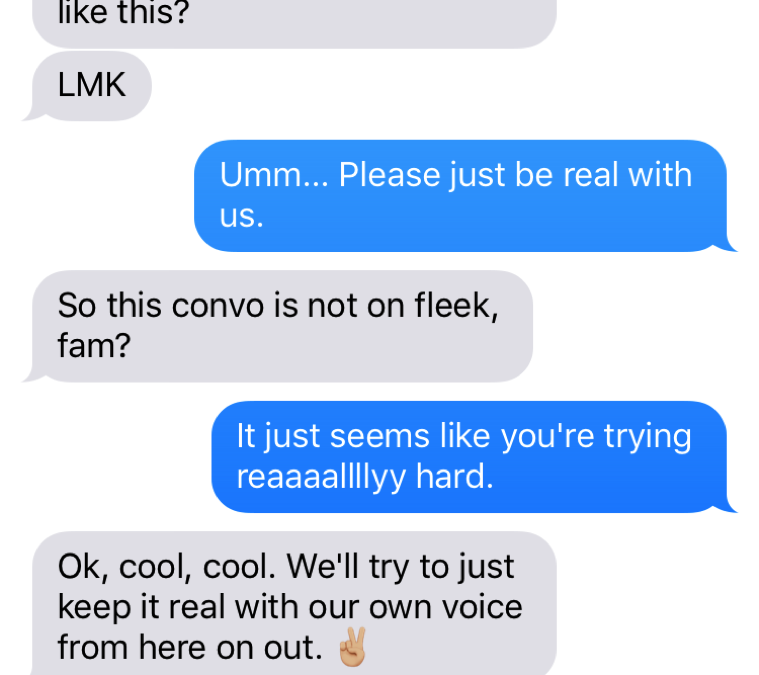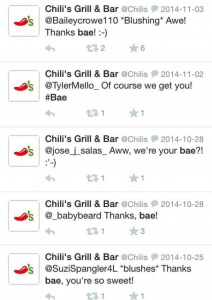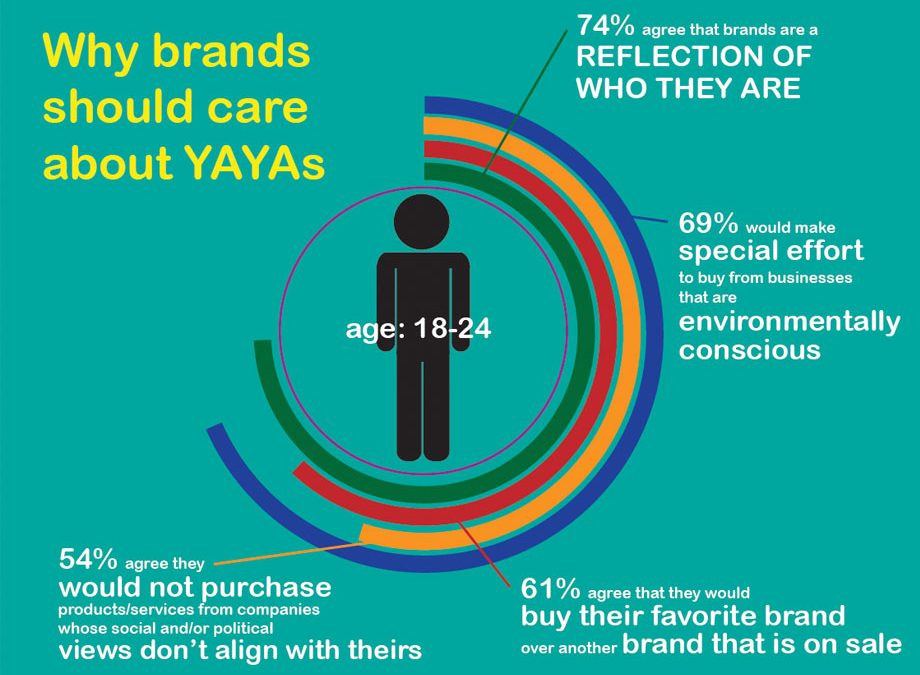
Internet slang has a place, but is that place in advertising? Text lingo and abbreviations are serious things for a brand to throw around because audiences are so polarized on the subject. There’s no doubt that brands use “slanguage” to target the YAYA demographic, but what do 18- to 24-year-olds really think of text talk?
Although keeping the vocabulary “hip and with it” can be helpful in some situations, it’s important not to force or fake it. YAYA consumers value authenticity, so it’s vital that a brand stays aligned with its voice and personality. Nobody likes a try-hard, especially young people. Sincerity is a brand’s best bet at peaking and keeping the interest of YAYA consumers.
Using text lingo and internet slang should come naturally, or odds are this demographic will tune out your message entirely. But don’t be discouraged from stepping into the YAYA world and trying to better understand phrases this age group uses on the reg. Just double check that this tactic makes sense in the context. According to our annual State of the YAYA report, 77 percent of YAYA consumers say that it’s more important to be unique than to be popular, showing just how much they value authenticity both for themselves and from brands.
The bottom line is that text lingo and internet slang have a defined place in advertising. We’re fans because it keeps the conversation fun. Unless you overuse the word “bae.” We’re looking at you, Chili’s.*

TTYL,
Macyn, Rosie, and Brianna
*Disclaimer: We actually love Chili’s. We’re big fans of Chili’s.
Written by: Macyn Gillespie, Rosie Hutchison and Brianna Olson

Youth and young adults, or YAYAs, have more resources than ever before when it comes to shopping. Gone are the days of basing purchases on word-of-mouth or remaining loyal to the brands their parents bought. Though YAYA consumers still rely heavily on the opinions of their peers, they have access to the opinions of millions with just a few taps on their smartphones. The prevalence of online reviews, discussion boards and social media chatter has changed the way the 18- to 24-year-old market shops. According to a Mintel report, 60 percent of YAYA shoppers say they read consumer feedback about products online before buying, and 37 percent say they compare product’s online prices to those found in-store. The abundance of information allows them a sense of individuality and to venture away from the traditional brands of older generations.
Although the YAYA demographic has enjoyed online shopping for a while, they now rely heavily on online purchasing after leaving their parents’ homes. For possibly the first time, they’re shopping and paying for things on their own, so they might as well do it in the way that comes easiest. YAYA consumers grew up with technology, which is constantly becoming more efficient and pervasive in their lives. There’s no reason why they wouldn’t be lured by the speed and convenience of online shopping. According to our annual State of the YAYA report, 86 percent of YAYA consumers agree they shop online because it’s available, and 89 percent do it because it’s quick or convenient. They are in a new phase of life with a jam-packed schedule, making the balance of work or school and a social life difficult. Online shopping encourages YAYA shopper’s newfound independence and helps them take a step toward that work-life balance.
YAYA consumers also use online shopping to construct an identity for themselves. According the 2016 State of the YAYA market survey, these shoppers are extremely brand loyal, but not to their parents’ brands. With an infinite selection at their fingertips, they are departing from childhood brands and moving toward brands that reflect their adult personalities. The survey found that more than 70 percent of YAYA consumers agree the brands they choose are a reflection of themselves. Additionally, more than 60 percent say they will buy their favorite brand regardless of what is on sale.
YAYA shoppers choices go beyond the look and feel of items, as they discern what brands will say about their interests, concerns and lifestyles. More than half of this demographic agrees that they would not purchase products or services from companies whose social or political views do not align with their own. To attract these consumers, marketers need to consider what kind of social image their brand embodies. Aligning a brand with positive changes like environmental conservation or social acceptance goes a long way with YAYA shoppers.
It is nothing new that purchase habits change as one enters adulthood, and that is clearly the case for the YAYA demographic. But what is new is going through this life stage with an abundance of new technologies, social norms and means of crafting an identity. They are searching for a purpose in their young adult life while experiencing the thrill of making purchase decisions alone. Aligning your brand with the habits of these social, tech savvy YAYA consumers will get you loyal customers in no time. If your brand fits into their identity, they won’t be able to stay away.
Written by: Maddy Jones, Jamie Lazaroff and Jackie Olson

Snap Inc. has done it again. The company that created Snapchat, one of the most popular apps in the history of the smartphone, is now taking the world by storm (again) with Snap Inc. Spectacles.
If you’re thinking to yourself that the last pair of tech glasses you bought (cough, Google Glass, cough) didn’t turn out to be revolutionary, just expensive, that’s fair. However, the Snap Inc. Spectacles are different in that they will record whatever image they are focusing on, providing a point-of-view that has never been captured before. As far as the hit to the bank account, an article by AdAge stated that the cost of the glasses is a mere $129, making them attainable for even the poorest of college students looking for cutting-edge tech.
In regards to how the video will come to life, it will look a lot like footage from movies like “Paranormal Activity.” The Spectacles have the versatility of a GoPro, but allow for greater stability and no need for suction cups or inconvenient straps. Perhaps the best feature is the simple tap to record function. To create a video, simply tap the side of your Spectacles, and the glasses will record a 10-second clip that is uploaded straight to your Memories in Snapchat. Given the functionality and affordability of this product, there is no question that it will appeal to YAYA consumers.
So, the next time you reach for a pair of glasses, you might consider the Snap Inc. Spectacles that provide the best way yet to capture life’s best moments.
Written by: Amanda Manno, Brad Nachtrieb and Zach Stoner

For years, all marketers have talked about is millennials. They showered attention and money on them. But as millennials age, what should they do?
That’s where the YAYA market comes in. These 18- to 24-year old youth and young adult consumers are an elusive yet essential group for brands’ to target. Marketing to those in this life stage requires as much energy as daily exercise and flossing and it’s just as important. So when it comes to knowing what this age group is about, brands can turn to MOJO Ad for help in sifting through the fads and trends.
The YAYA market represents approximately 10 percent of the U.S. population, or 31 million people. While roughly 40 percent of YAYAs are pursuing higher education at a two or four-year institution, or are in the beginning stages of their careers, they have an impressive buying power. We know that reports indicate that millennial spending power will reach $1.4 trillion by 2020, meaning the buying power of the YAYA demographic will also grow concurrently as they move into the work force. Gaining the attention and the trust of the influential consumers in this life stage is essential for the long-term success of brands.
Possessing insight into the workings of this demographic will help brands to separate from their competitors. Current YAYA consumers believe in companies that are transparent and honest. Trying to use trite, deceptive marketing tactics won’t work for them. This is one of the many ways YAYA research can help companies tailor marketing plans to effectively reach this market.
The biggest thing for brands to remember is that the YAYA demographic isn’t a generation, it’s a life stage. So 10 years from now, when millennials move into middle age and the up-and-coming iGen is starting their families, the YAYA market will still be 18 to 24 years old. That’s why they aren’t the next big thing, they are the only thing.
Written by: Michael Wang, Maris Smith and Jacob Renie

It shouldn’t come as a surprise that young adults aren’t as in love with cash as their parents were. According to a 2014 ICBA study, one in four millennials carry less than $5 cash on them on any given day. The same holds true for the YAYA (youth and young adult) market of 18 to 24-year-olds who are using either debit or credit cards for the majority of their purchases. With this group, tangible currency is losing relevance. But here’s where cash does have prominence–in an industry frequently visited by this mostly cashless YAYA demographic: pubs and bars.
Many bars still require cover charges to be paid in cash. There’s also a typical minimum charge required to pay for drinks with a debit and credit card. These are often the only reasons YAYA consumers stop at ATMs before heading out for the night.
The mobile money app Venmo lets users transfer money for free, giving them to option to write a description for the payment. According to an article by Recode, the amount of money transferred through the app increased from $1.26 billion in 2015 to $3.2 billion in 2016. The YAYA demographic often uses emojis instead of words as a fun way to illustrate the payment exchange. Alcohol-themed emojis are four of the top 10 emojis used in Venmo descriptions, indicating that the YAYA demographic is paying friends back for drinks through the app.
Pubs and bars should capitalize on this common exchange practice. If alcohol-serving establishments began utilizing Venmo for anything from cover charges to the nightly specials, YAYA customers would enjoy more frequent and convenient transactions. Cashless young adults would be grateful to use the virtual currency they prefer and could even begin choosing which bars to go to based off their acceptance of Venmo.
So for bars looking to improve the flow of revenue from YAYA crowd, remember to tap into the Venmo trend.
Written by: Nicole Caldwell, Clayton Conness and Mara Worley





